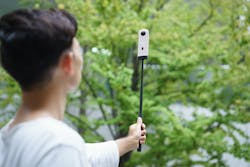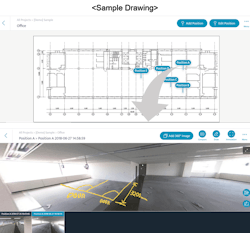Latest from Technology
Sponsored
360-Degree Cameras: A Must-Have Tool for Construction Professionals
When sharing project updates with clients or team members, sometimes it’s easier for them to be onsite with you. Of course, that is not always possible or practical, so why not bring them to the construction site virtually? RICOH THETA’s 360-degree cameras are essential tools for tracking progress and communicating updates with clients and other project stakeholders. By taking 360-degree images of projects, those who are offsite can see everything, as if they were in the middle of it all, and quickly provide meaningful feedback.
Let’s explore how these gadgets can benefit construction professionals.
Surveying plots of land
When planning a construction project, it is critical to have an accurate survey of the land. Japan-based architect Waka Kimizuka uses his RICOH THETA camera to document new jobsites. By attaching his camera to an extendable monopod, he can get a vantage point from a range of higher elevations to gauge various views, the angle of the sun, the position of the windows and the surrounding landscape in the vicinity—all before breaking ground.
Documenting dangerous or hard-to-reach places
Beyond surveying land, 360-degree cameras are also useful tools for photographing spaces that are not normally visible or easily accessible for inspection.
Mr. Onishi, a Japan-based contractor specializing in outdoor sign installation, finds his RICOH THETA useful for hanging signage in precarious locations. When installing a sign, he must check the site before commencing work, but the areas are often dangerous (i.e., building rooftops) where he cannot easily take clients. By photographing the space in 360, he can give his clients a virtual, yet realistic view of the area without compromising their safety. He finds that 360 images paint a much clearer picture of the environment than verbal descriptions and regular 2D imagery.
Some professionals, such as Japan-based architect Waka Kimizuka, use 360-degree cameras to get a better view of crawl spaces or attics in buildings to ensure the structural columns and frames are in place properly. He captures these areas with his RICOH THETA on a monopod or tripod, then compiles a comprehensive set of images that he can reference in later phases of construction or future renovations when changes need to be made.
Capturing critical details during different phases of construction
Texas-based architect Franco Albarran of Albarran Architects uses his RICOH THETA to document the different phases of his projects. He finds 360-degree photography most helpful when documenting the pre-drywall cover phase of construction. Before drywall is applied and covers up mechanical components like HVAC ducts, plumbing lines and electrical wiring, he uses the 360-degree camera to document exactly where these critical pieces of infrastructure are. This information is incredibly valuable down the road as clients look to hang artwork, shelving, or televisions, or embark on renovation projects.
Sharing progress and collaborating with teams
To help architects, contractors, and designers collaborate through all phases of a project life cycle, RICOH THETA developed a proprietary platform that digitizes the entire jobsite. RICOH360 Projects allows teams to upload, organize, and share 360-degree images taken at the jobsite into one seamless platform. Team members can then collaborate and make comments directly on the 360-degree images about changes that need to be made, ultimately reducing the number of trips taken to the site and potentially reducing or eliminating delays.
In addition, there are many other ways to share 360-degree images with free apps and services. RICOH THETA offers an official PC app (RICOH THETA for Windows and Mac) to view and share. Google Photos are also compatible with THETA and provide an easy platform for sharing.
For more on 360-degree photography and how it can be utilized for construction work, visit theta360.com.




